Scallion Pancakes

introduction
Scallion pancakes, the oldest pancakes in the world, are really scallion-stuffed pan-griddled flatbread wrought of unleavened dough. Ubiquitous in China and sold from street carts and store freezers, scallion pancakes wait cozily on many Asian-American restaurant menus, too. Scallion pancakes possess the unimpeachable allure of ancient flatbread: a tinsel-crisp exterior, layered flakiness, and a cushioned bite that, in their case, gives way to a steaming-sweet spring onion interior. When they’re right, they’re insanely delicious. We believe we’ve created a scallion pancake recipe that honors the finest form and flavor of this ancient bread. But it took a long time and a lot of pancakes.
We nominated our premium flatbread flour, Anson Mills Trigo Fuerte, for the principal task. The instinct was a good one, but because other elements of our initial recipe were woefully miscalculated, we judged the flour too strong. Back to the freezer it went. Enter stand-by favorite, Anson Mills Fine Cloth-Bolted Pastry Flour. Testing proceeded apace. We watched several videos narrated in Mandarin! We’re not exaggerating when we tell you that every imaginable element in this recipe was scrutinized and tested: the amount and temperature of the water, the mixing method, the quantity of and which parts of the scallions to use, the thickness of the rolled pancakes, the type of oil in the dough and in the skillet, the type of skillet and its heat setting, how long to fry. We could go on and on. (We did go on and on.) Only at the very end of the process did we offer Trigo Fuerte another shot at fame. One final tweak in hydration, and yessss—we got what we came for.
These scallion pancakes are, frankly, sensational. They’ve got looks, flakiness, pleasant give to the bite, and a mind-bendingly creamy scallion-forward interior. They also get the spicy deep wheat of Trigo Fuerte and sweet punctuations induced by the Sonora wheat bran flakes in this flour blend. Oh, and there is also a soprano ping of toasted sesame flavor inside the pancake that is robust enough to compliment the flour. It’s all good. Crazy good.
Cooking Remarks
Most recipes for scallion pancakes call for just the green sections. But we found the moist white part of the scallion offers both increased flavor and creaminess to the pancakes’ interior. Don’t precut the scallions and leave them sitting around—they lose their fresh, sweet flavor and taste like soap!
We like butter for the interior of the pancakes, but oil for the outside.
You’ll note that we don’t use extra flour for the majority of the handwork involved in forming these pancakes. Extra flour isn’t necessary! Don’t be tempted to go there: your pancakes won’t be as good. End of story.
The simple truth is that these pancakes cook better in a nonstick pan. It isn’t that they’re particularly sticky. But if they can take the initial browning without the addition of fat, the final finish will crisp and light with no trace of greasiness.
equipment mise en place
For this recipe, you will need a digital kitchen scale, a medium mixing bowl, a whisk, a teakettle, a liquid measuring cup, a digital thermometer, a pair of chopsticks, a gallon-size zipper-lock bag, a small bowl or ramekin, a small skillet, a small mixing bowl, a small or medium suribachi (Japanese mortar) with a surikogi (Japanese pestle) or a clean coffee grinder used exclusively for grinding spices, parchment paper, a pair of scissors, a bench knife, a rolling pin, a ruler, a clean kitchen towel, a heavy-bottomed 10-inch nonstick skillet or a well seasoned 10-inch cast-iron skillet, a pastry brush, and a thin metal spatula.
-
for the pancakes:
-
10ounces (2 cups) Anson Mills Trigo Fuerte Flatbread Flour, plus additional for rolling the dough
-
¾teaspoon fine sea salt
-
Spring or filtered water
-
2tablespoons Anson Mills Sea Island Benne Seeds
-
2bunches of slender scallions, washed and trimmed
-
2tablespoons European-style butter, melted and cooled slightly
-
Flaky sea salt, for seasoning the scallions
-
Freshly ground white pepper, for seasoning the scallions
-
Raw (untoasted) sesame oil, for brushing the pancakes
-
-
for the dipping sauce:
-
3tablespoons soy sauce
-
2teaspoons spring or filtered water
-
2teaspoons toasted sesame oil
-
2teaspoons rice vinegar
-
1½teaspoons sugar
-
Pinch of red pepper flakes
-
0.2ounce (½-inch) knob of fresh ginger, peeled and smashed
-
1scallion
-
-
Make the pancakes: Turn the flour and fine sea salt into a medium mixing bowl and whisk to combine. Fill a teakettle about half full with spring or filtered water and bring it to a boil. Set a liquid measuring cup on a digital kitchen scale and tare the scale. As soon as the kettle whistles, pour 6 ounces (¾ cup) of boiling water into the measuring cup. Place a digital thermometer in the cup and let the water cool until it is 150 degrees; this should take just a couple of minutes.
-
Pour the hot water into the flour and stir with chopsticks until a rough dough comes together (fig. 2.1). With your hands, lightly knead the dough in the bowl (fig. 2.2) until it forms a cohesive mass. Transfer the dough to a counter top and knead without adding flour until it is smooth, satiny, and elastic (fig. 2.3), about 5 minutes. Turn the dough into a gallon-size zipper-lock bag, seal the bag, and allow the dough to rest for 30 minutes.
-
While the dough is resting, make the dipping sauce: In a small bowl or ramekin, combine the soy sauce, water, sesame oil, vinegar, sugar, red pepper flakes, and ginger. Stir until the sugar dissolves (fig. 3.1). Set aside.
-
Also while the dough is resting, in a small skillet over medium-low heat, toast the benne seeds, stirring very frequently, until they are a shade darker in color and only lightly fragrant. Don’t over-toast them, as they will become bitter if you do. Pour the seeds into a suribachi, if you own one, or into a clean coffee grinder used exclusively for grinding spices and let the seeds cool completely. If you’re using a suribachi, grind the seeds with a surikogi, or pulse them in the spice grinder, until they are broken down to a coarse powder (if you’re using a spice grinder, be careful not overprocess them, lest they become an oily paste). Empty the seeds into a small bowl. Finely chop enough scallions (fig. 4.1) to yield 1½ cups (3.5 ounces) and add them to a small mixing bowl. Drizzle the scallions with the butter, stir with a fork until the butter is evenly distributed, and set aside.
-
Cut four 12-inch squares of parchment paper and set them aside. Pull the dough out of the zipper-lock bag—the dough may try to leave bits of itself behind in the bag, but they will pull away easily and reincorporate into the mass of dough. Cut the bag open with scissors, creating a large sheath, and set aside. Using a bench knife, divide the dough into 4 equal pieces (4 ounces each, if you’re keeping score). Without adding flour, round the pieces against the counter with the palm of your hand. Place 3 of the pieces on a plate (fig. 5.1) and cover them with a clean, barely damp kitchen towel. Sprinkle a parchment square with flour, set the fourth round of dough on the paper, and sprinkle flour on top. Using a rolling pin, roll out the dough to an 8- by 7-inch rectangle. Gently lift the dough to make certain it isn’t sticking to the parchment and lightly flour underneath if necessary. Distribute one-quarter of the buttered scallions evenly over the rectangle, then sprinkle evenly with one-quarter of the ground benne seeds, a big pinch of flaky sea salt, and a little white pepper. Starting from a long side, tightly roll up the dough, using the paper to lift the lip (fig. 5.2) and help roll it. You will have a cylinder about 9 inches long (fig. 5.3). Pinch together the seam and the open ends to seal them. Roll the cylinder back and forth on the counter to lengthen it by a couple of inches. Pick up one end of the cylinder, hold the other end in place, and coil the cylinder around the fixed end to form a snail (fig. 5.4); tuck the end under the coil. Flour the parchment square, place the coil on top, and cover with the reserved zipper-lock bag. Roll out, fill, and coil the remaining 3 pieces of dough in the same way.
-
Set a heavy-bottomed 10-inch nonstick skillet or a well-seasoned 10-inch cast-iron skillet over medium heat. Lift the first dough coil off of its parchment square, dust the parchment with flour, and place the coil back on top. With your hand, gently press the coil to flatten it slightly (fig. 6.1). Sprinkle flour on top and roll the dough into a 7-inch circle (fig. 6.2) of even thinness; it’s fine if some scallion pieces peek out. Do not roll the pancake too thin! Loosen the dough circle from the paper, set it back on top, and lightly brush the surface of the dough with raw sesame oil. Pick up the dough circle by the paper and carefully invert it into the hot skillet. Peel off the paper, brush the second side of the dough with raw sesame oil, and cook for about 2 minutes, peeking underneath to check for browning. Using a thin metal spatula, flip the pancake, and then use flat wooden spoons or tongs to gently crumple the pancake (fig. 6.3) to coax its layers into separating. Cook until the pancake is spotty brown, toasty, and appealingly burnished (fig. 6.4), about 4 minutes longer.
-
While the first pancake cooks, roll out a second pancake and have it ready to cook. When the first pancake is ready, transfer it to a cutting board and let it cool for a minute or two. Meanwhile, finish the sauce: remove and discard the ginger, thinly slice the scallion, and add it to the sauce. Cut the pancake into 8 wedges (fig. 7.1) and serve with the dipping sauce. Cook the second pancake and roll and cook the third and fourth pancakes in the same way as the first.
-
-
2.1

-
2.2

-
2.3
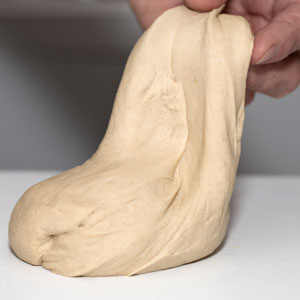
-
-
-
4.1

-
-
-
5.1

-
5.2

-
5.3
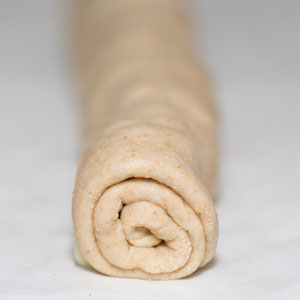
-
5.4
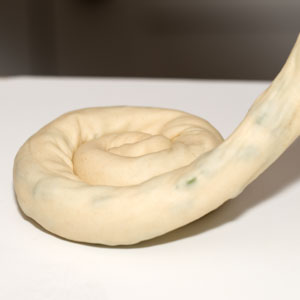
-
-
-
6.1

-
6.2

-
6.3
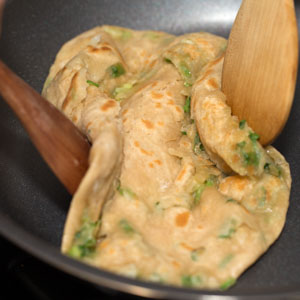
-
6.4
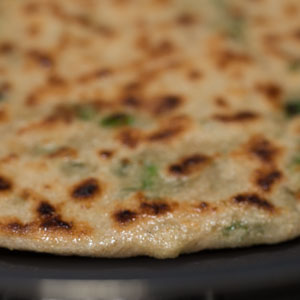
-
-
-
7.1

-